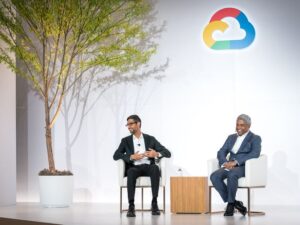What are the benefits of a cloud-first approach to consumer experiences?
If old IT solutions are forcing you to use up too much of your energy on data-storage issues and keeping your legacy alive, then you will not be able to focus on business goals and spending enough time on your customer experience. We are in scaling mode, growing very strongly above market and need to achieve strong efficiencies in the coming years, only then can we fulfil our ambitions in terms of delighting customers, sustainable growth and innovation power.
Economies of scale are ultimately the foundation of a successful digital business model. Our cloud-first strategy is one of the key enablers. Today we have a strong focus on Cloud Native Development, which allows us to build new, highly scalable and adaptable solutions, in an always on approach. The results are highly reliable services and fast reaction times based on our data-based business and customer insights.
How will digital ecosystems look in consumer insurance?
The ecosystems of the future will increasingly consist of integrated solutions for customers. They also open the possibility of interacting with non-paying-customers in a meaningful way, outside of the insurance context. Even former customers can be held close to the company, by offering services in an ecosystem.
On the one hand, embedded insurance opens many new opportunities for insurance companies: The Consumers’ needs can be addressed outside the insurer’s sales process with solutions tailored to their buying behavior. This can be done without interrupting the customer’s sales process, for example while buying a car, renting a flat or managing financial services.
On the other hand, we must think bigger about ecosystems. It’s not only about embedded solutions, but also about being present when users don’t have an immediate need for insurance. Therefore, it is crucial to rethink customer propositions and to have a much stronger focus on services, rather than technical insurance products.
How are the use cases for gamifications evolving in the insurance space?
So far, there are few examples of gamification that work in our industry. Although many companies have racked their brains over how to use playful elements to increase both the frequency of interaction and the loyalty of prospects and customers, there is a lack of the necessary customer centricity. In my opinion, our industry is currently failing to meet the challenge because the solutions are not developed from the customer’s point of view and are not implemented consistently enough.
Just look at today’s existing telematics offerings. Pay-as-you-drive models, for example, are largely advertised in a monetary context, but do not have any playful and emotional elements for the customer. Instead of just offering premium reductions, we should add value by offering features such as community rankings, drive challenges or even rewards and badges for good performance.
At the end of the day, these are the elements which increase loyalty, whereas variable premiums can cause the opposite. In addition to this, it is essential to open up the solutions for prospects, the customers of the future. The industry is still failing in rethinking their “playground”.
How can insurers convince customers of the value of sharing their data?
Nowadays it has become normal for consumers to share their data, as long as they can count on transparency concerning usage and generate value from it. More and more people are learning that they can use their personal data as currency in the digital age. We have had some great success in winning new users through trading data. For example, a Smile App User is willing to trade his name, mobile phone number, e-mail and date of birth for our free online purchase protection.
With the same data, the user is willing to activate a telematics service offered by Smile which tracks his driving behavior, as long as he gets rewarded for safe driving and does not receive a disadvantage in the insurance premium. Sharing data always goes hand in hand with the potential gain for both parties and at the end it is our challenge to offer value for the data given.
Is a freemium approach the future of consumer insurance distribution?
In September 2021, we launched Europe’s first freemium model. Today we are already seeing the first positive results, with our first 10,000 users, all non-paying-clients. These users have been interacting with different services on the Smile App, in exchange for their data. There are few reasons why the business model should not work for insurers, when it shows so much potential in other industries.
I strongly believe that the value of a customer is not the price paid for a premium, but the person itself. We need to stop only focusing on paying customers. If we can become indispensable to users, they will become customers in some way or another and revenue and profit will follow.
To master the freemium model, insurance companies need to reinvent themselves and create services that continuously bring added value to the user. In doing so, we need to move outside our own comfort zone. Ecosystems, for example, offer a lot of potential for this. Start there, even if consumers don’t have an immediate insurance need.








